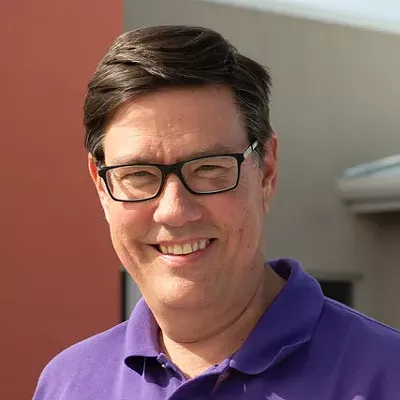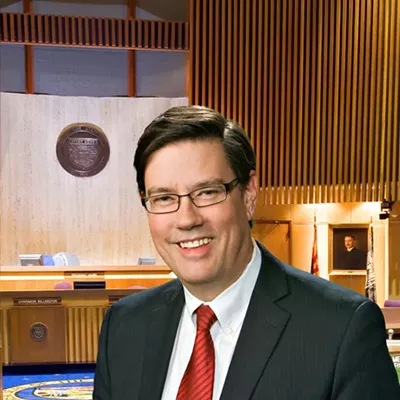The art project, which depicts a day when downtown was still a bustling city center, works as an effective hook, giving Farley a chance to talk about his political work in the community.
Farley, 42, is best known politically for the unsuccessful 2003 transit proposition that would have built a light-rail system, expanded bus service and repaired neighborhood streets. The initiative helped Farley develop a core group of supporters, particularly in the city center.
"He can make things happen, and it's not in the traditional political way," says local attorney Clague Van Slyke III, who worked with Farley on the light-rail proposition. "He has great ideas; he has a lot of vision, and he can get things done by bringing people together. And I don't think he'd be hidebound by traditional political ties."
Farley grew up in the Los Angeles suburb of Ontario. After high school, he headed east to Williams College in Williamsburg, Mass., where he earned a degree in political science. His interest in the major was driven largely by a desire to spend his junior year abroad in Cairo, Egypt. "I wanted to go somewhere that was totally and utterly foreign," he says.
He met wife Regina Kelly in Williamsburg, and the couple relocated to San Francisco in 1987 so she could pursue a theater career. Farley spent about four years in the art department of the independent weekly San Francisco Bay Guardian before quitting to launch his own graphic design firm.
In the mid-'90s, Farley moved to Tucson. "It just felt like home," Farley remembers. "The heat in the summer, I really crave that."
Farley got started in local politics after volunteering on a citizen's committee to study alternatives for the Fifth/Sixth Street corridor. He felt as though city officials ignored the committee's recommendations for increasing mass transit and discouraging traffic.
"When the city ignores people who have spent that much time getting involved, then there's something really wrong," Farley says.
When the city put a road-heavy plan on the ballot in 2002, Farley was among the leaders opposing the proposition, which lost by a nearly 2-1 margin.
After that campaign, Farley followed up with the 2003 light-rail initiative, which was rejected by roughly 63 percent of voters citywide.
Following the light-rail loss, Farley joined the citizen's committee of the Regional Transportation Authority, helping develop the draft plan that is now under review by county residents. Farley thinks the plan is mostly solid, although he criticizes plans to spend $200 million expanding Aviation Parkway from Golf Links Road to Interstate 10. Naturally, he thinks some of the money would be better spent on mass transit.
But Farley bristles at the notion that he only knows about transportation. "Dismissing me as a single-issue candidate is totally off-base," he says.
He says he's been involved in downtown revitalization as secretary of the Tucson Downtown Alliance. He's also been involved in education through his wife's non-profit, Voices, Inc., which has helped young people develop journalism and publishing skills, as well as collecting oral histories for a variety of book projects.
Farley calls his campaign an experiment: "Can a person who really cares about the issues and really wants to get things done get elected to office when he's honest about what he wants to do?"











